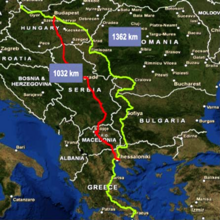Railway line Budapest – Belgrade – Skopje – Athens
The planned railway line Budapest – Belgrade – Skopje – Athens - a China-CEE - "Labeling Project " (2014) of the Chinese Belt and Road Initiative - is a project for an international high-speed line in Central / Eastern Europe between Budapest (Hungary), Belgrade (Serbia), Skopje (North Macedonia), Athens and the China-operated port of Piraeus (Greece). With a planned speed of 160 km / h on the new Budapest – Belgrade railway line and 200 km / h to 250 km / h on the Thessaloniki – Athens railway line . The Chinese planners have not yet announced any realizable speeds for the other routes. Originally, speeds of up to 300 km / h were planned throughout.
The first line to be realized, the Budapest – Belgrade line - with planned Chinese investments of USD 2.89 billion for the expansion to a 350 km long high-speed line - should have been completed within two years. The expansion, which had already started on the Serbian side, came to a standstill in 2018.
Until today (2017/18) this China-CEE project is in contradiction or runs parallel to the EU planning of the Trans-European Transport Networks ( TEN-T ).
EU planning

In a report by the EU Commission 2012/2013, Priority Project 22: Railway axis Athens – Sofia – Budapest – Vienna – Prague – Nuremberg / Dresden (PP22), the planners presented their ideas on the new management of the “ Balkan Route ”, the pan-European transport corridor X (Corridor X) through Austria , Slovenia , Croatia , Serbia , North Macedonia and Greece ( Thessaloniki - Skopje - Belgrade - Budapest / Zagreb - Ljubljana - Graz / Salzburg ), the Athens - Budapest route planned to date via Bulgaria and Romania at 330 km shortened - approx. 1,030 km compared to 1,362 km of the previous southern PP22 planning. The new route also has a number of other technical advantages: 89% of the Balkan route is electrified, compared to 75% of the previously planned PP22 route and the route allows high speeds. In return, 64% of the planned line is single-track, compared to 54% of the previous PP22 route.
The planners address their words to politicians: “In the medium term, it may be necessary to coordinate the priorities for the European Union, the main funding agency, and for the member states concerned with what is feasible. In this regard, Croatia's accession to the European Union in July 2013 and the talks with the republics of the former Yugoslavia in connection with the review of the TEN-T policy offer a useful opportunity to develop rail links between south-east and central Europe via the Western Balkans . "
Individual evidence
- ↑ a b (en) Another Silk Road fiasco? China's Belgrade to Budapest high-speed rail line is probed by Brussels. by Wade Shepard, Forbes February 25, 2017
- ↑ (en) China to finance construction of new Budapest-Belgrade railroad. Hungary Today , December 17, 2014
- ↑ (en) Belgrade-Budapest railway part of Chinese 'express lane' to Europe. by Aleksandar Vasovic, Reuters / Daily Mail , December 17, 2014
- ↑ a b c (en) Priority Project 22: Railway axis Athens – Sofia – Budapest – Vienna – Prague – Nuremberg / Dresden. Annual report by the coordinator, Gilles Savary , European Commission , Brussels, October 2013